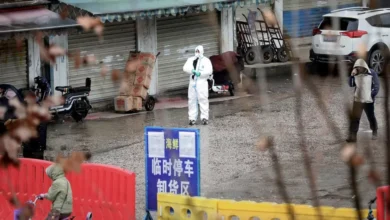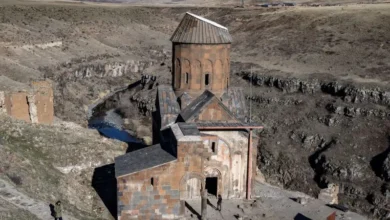‘The only way for us to survive’: The life of a New York City candy seller

A clock on the electronic display flickers to noon above the bustling Times Square subway station in New York City. Amid the lunchtime crowd of commuters and tourists stands María, a 31-year-old single mother from Ecuador whose daily life revolves around this transit hub.
It is here, in the tunnels underneath the city, that María earns the money she needs to survive.
On her back is her two-year-old daughter, and in her hands is a colourful tray of candy, crammed with packages of M&Ms and Kit Kat chocolates and sticks of Trident gum.
From the Times Square station, María can hop on and off the Number 7 train, a popular link to the borough of Queens. As she walks from one carriage to the next, she repeats “candy” and “dollar” — two of the few words she knows in English — hoping to make a sale.
Most people, however, look away. Others become aggressive, María said.
New York City is in the midst of an immigration crisis, with more than 113,300 asylum seekers arriving since 2022 — and too few shelters to house them. With the city’s immigration policies in the spotlight, María’s interactions with the public can be tense.
“People insult us or record us without authorisation, accusing us of importing bad habits and poverty from home,” María said. “They don’t understand our situation.”
María — who is using a pseudonym to protect her privacy — is part of a population of largely Ecuadorian candy sellers who make a living on the New York City subway system.
Peddling sweets is familiar work for María: It is the same job she used to do in her hometown in the province of Cotopaxi. But it is also a necessity. Without legal papers authorising her stay in the US, finding steady employment is difficult, seemingly impossible.
“It’s what my cousin and other women from Ecuador I know do because there are no job opportunities. It’s the only way for us to survive,” María explained.
But each sale only nets her one dollar, maybe two. After working 13 hours straight, from 7am to 8pm, she might come home with $50 on a good day, $10 on a bad one.
Still, the pressures in her home country forced her and other Ecuadorian migrants to arrive here and eke out a living on the subway lines.
A ‘third wave’ of Ecuadorian migration
By the end of September, the US Border Patrol had apprehended 117,487 Ecuadorians for the fiscal year 2023 — more than four times the previous year’s total.
Anthropologist Soledad Alvarez, a professor at the University of Illinois Chicago, considers this spike part of Ecuador’s third major “wave” of emigration since the 1980s.
She told Al Jazeera the current exodus began in 2014, “caused by the decline in oil prices”.
“Then the pandemic came and hit Ecuador severely,” she said. “Since then, this crisis has deepened under the administrations of Lenin Moreno and Guillermo Lasso, leading to substantial migration in recent years.”










